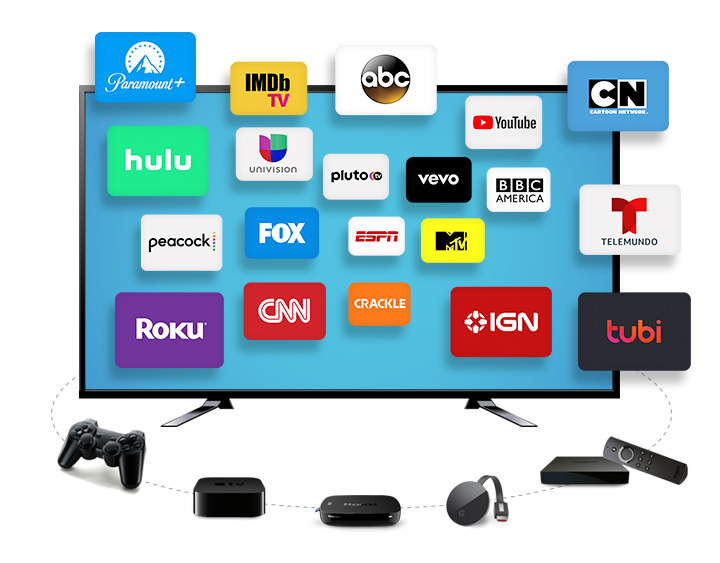What is CTV Advertising
CTV advertising stands for Connected TV advertising. It refers to video ads that you see on streaming services like Hulu, Netflix (with ads), or Disney+, on devices like smart TVs, gaming consoles, or streaming sticks.
Here’s a breakdown of what CTV advertising is all about:
- Where you see it: CTV ads are shown during streaming content, just like commercials during traditional TV broadcasts, but on internet-connected devices.
- Targeting: Unlike traditional TV ads, CTV ads can be targeted to specific audiences based on demographics, interests, and viewing habits. This means you’re more likely to see ads relevant to you.
- Measurement: CTV advertising allows for better measurement of ad effectiveness compared to traditional TV. Advertisers can track things like impressions, clicks, and even conversions to see how their campaigns are performing.
Understanding Connected TV (CTV)
What is Connected TV?
Connected TV refers to any television that can connect to the internet and stream digital content. Unlike traditional televisions that rely solely on cable or satellite, CTVs open a gateway to a plethora of online content. Don’t Miss to Check Out Our Website: CANSPECTIVE
Different Types of CTV Devices
There are various devices under the CTV umbrella:
- Smart TVs: These come with built-in internet connectivity and streaming apps.
- Streaming Devices: Gadgets like Roku, Amazon Fire Stick, and Apple TV that connect to regular TVs, making them “smart”.
- Gaming Consoles: PlayStation, Xbox, and other consoles that support streaming apps.

How CTV Advertising Works
The Technology Behind CTV Ads
CTV advertising leverages internet connectivity to deliver video ads to users via streaming platforms. These ads can be pre-roll (before content starts), mid-roll (during the content), or post-roll (after the content ends). The precision of internet-based delivery makes targeting incredibly accurate.
Types of CTV Ads
- In-Stream Ads: Similar to traditional TV ads, these play during streaming content.
- Interactive Ads: These engage viewers by allowing them to interact with the ad content.
- Branded Content: Seamless integration of brand messaging within the content.
Benefits of CTV Advertising
Enhanced Targeting Capabilities
One of the standout benefits of CTV advertising is the ability to target audiences with precision. Brands can use demographic data, viewing habits, and even purchase history to ensure their ads reach the right people.
High Engagement Rates
CTV ads often boast higher engagement rates compared to traditional TV. Since viewers choose what and when to watch, they are generally more engaged, making them more receptive to ads.
Comprehensive Analytics
CTV provides detailed analytics, allowing advertisers to track metrics such as impressions, views, and conversions. This data helps in refining and optimizing ad strategies.
CTV Advertising vs. Traditional TV Advertising
Key Differences
- Targeting: Traditional TV relies on broad demographics, whereas CTV uses precise data.
- Measurement: CTV offers detailed insights, unlike traditional TV’s basic metrics.
- Flexibility: CTV allows for more dynamic and adaptable ad placements.
Advantages Over Traditional TV Advertising
CTV ads are less likely to be skipped compared to traditional TV ads. Plus, the interactive nature of CTV can lead to higher engagement and better ROI.
Popular Platforms for CTV Advertising
Major Streaming Services
- Netflix: Although traditionally ad-free, Netflix is exploring ad-supported models.
- Hulu: Offers various ad-supported plans.
- Amazon Prime Video: Provides advertising options through its Freevee service.
Emerging Platforms
- Peacock: NBC’s streaming service with a strong ad-supported model.
- Disney+: Recently introduced ad-supported subscriptions.
- YouTube TV: Combines traditional TV with digital streaming, offering robust ad opportunities.
Creating Effective CTV Ads
Best Practices for Ad Creatives
- Be Engaging: Capture attention within the first few seconds.
- Quality Production: High production value is crucial for viewer retention.
- Clear Call-to-Action (CTA): Guide viewers on what to do next.
Length and Format Recommendations
Keep ads concise—15 to 30 seconds is ideal. Longer formats should be compelling enough to maintain viewer interest.
Targeting Strategies in CTV Advertising
Audience Segmentation
Segment audiences based on demographics, viewing habits, and purchase behavior to create more personalized ad experiences.
Leveraging Data for Precision Targeting
Utilize data analytics to refine targeting strategies. This can include using first-party data from your own customer base or third-party data for broader reach.
Measuring the Success of CTV Campaigns
Key Performance Indicators (KPIs)
- Impressions: Number of times an ad is viewed.
- Click-Through Rate (CTR): Percentage of viewers who clicked on the ad.
- Conversion Rate: Number of viewers who took the desired action.
Tools and Techniques for Measurement
Use platforms like Google Analytics, Adobe Analytics, and specialized CTV ad platforms to track and measure campaign performance.
Challenges in CTV Advertising
Ad Fraud and Viewability Issues
Ad fraud remains a concern, with fraudulent impressions and clicks affecting campaign integrity. Ensuring viewability—confirming that ads are actually seen by real users—is essential.
Privacy Concerns
With increased data usage comes heightened privacy concerns. Compliance with regulations like GDPR and CCPA is crucial.
The Future of CTV Advertising
Emerging Trends
Expect more personalized ad experiences, increased use of AI for targeting, and integration of augmented reality (AR) and virtual reality (VR) in ads.

Predictions for Market Growth
The CTV ad market is projected to grow significantly, driven by the shift towards digital streaming and the decline of traditional TV viewership.
Case Studies of Successful CTV Campaigns
Example 1: Brand Success Story
A leading retail brand saw a 30% increase in sales by targeting specific demographics with personalized ads on Hulu.
Example 2: Innovative Use of Technology
An automotive company used interactive ads on Amazon Fire Stick to allow viewers to explore car features, resulting in a 40% increase in website visits.
How to Get Started with CTV Advertising
Setting Up Your First Campaign
Choose a platform, define your target audience, create engaging ad content, and set a budget. Use analytics tools to monitor and optimize performance.
Budgeting for CTV Ads
CTV advertising can be cost-effective. Start with a small budget and scale up based on performance and ROI.
Common Misconceptions About CTV Advertising
Myths vs. Reality
- Myth: CTV is only for big brands. Reality: Small businesses can effectively use CTV with targeted, budget-friendly campaigns.
- Myth: CTV ads are always skipped. Reality: High engagement rates prove otherwise.
Clarifying Doubts
Understanding the true potential and flexibility of CTV can help brands of all sizes leverage this powerful medium.
Conclusion
CTV advertising is a dynamic and powerful tool in the modern marketer’s arsenal. With its precise targeting, high engagement, and comprehensive analytics, it’s no wonder CTV is rapidly growing. Whether you’re a small business or a large corporation, embracing CTV advertising can significantly boost your marketing efforts.
FAQs
What is the main difference between CTV and OTT?
CTV refers specifically to internet-connected TVs, while OTT (Over-The-Top) encompasses any streaming media service delivered over the internet, including on mobile devices and computers.
How cost-effective is CTV advertising compared to digital advertising?
CTV advertising can be very cost-effective, offering better targeting and higher engagement, often leading to a better ROI compared to traditional digital ads.
Can small businesses benefit from CTV advertising?
Absolutely. With precise targeting and scalable budgets, small businesses can reach their ideal audience without breaking the bank.
What are the most effective types of CTV ads?
In-stream ads and interactive ads are particularly effective, as they engage viewers directly within the content they’re already consuming.
How do I choose the right platform for my CTV ad campaign?
Consider your target audience, budget, and campaign goals. Research platforms like Hulu, Amazon Prime Video, and emerging services to find the best fit for your needs.

Welcome to Canspective.ca, where Liam brings a unique perspective to the Canadian experience!
Liam is a talented writer who is dedicated to uncovering the stories that shape our nation and celebrating the diverse voices that make Canada so special. With a passion for exploring the intersections of culture, identity, and society, Liam’s articles offer insightful commentary and thoughtful analysis on the issues that matter most to Canadians.



